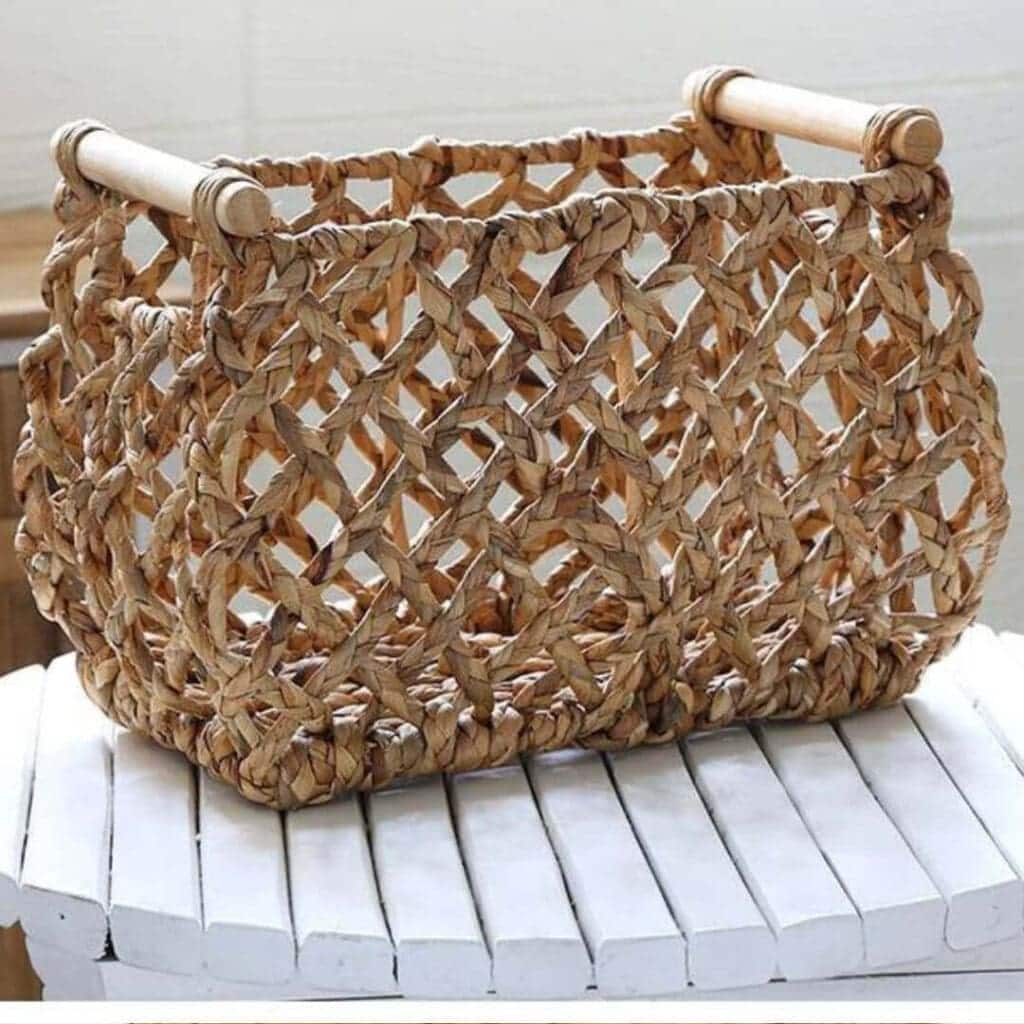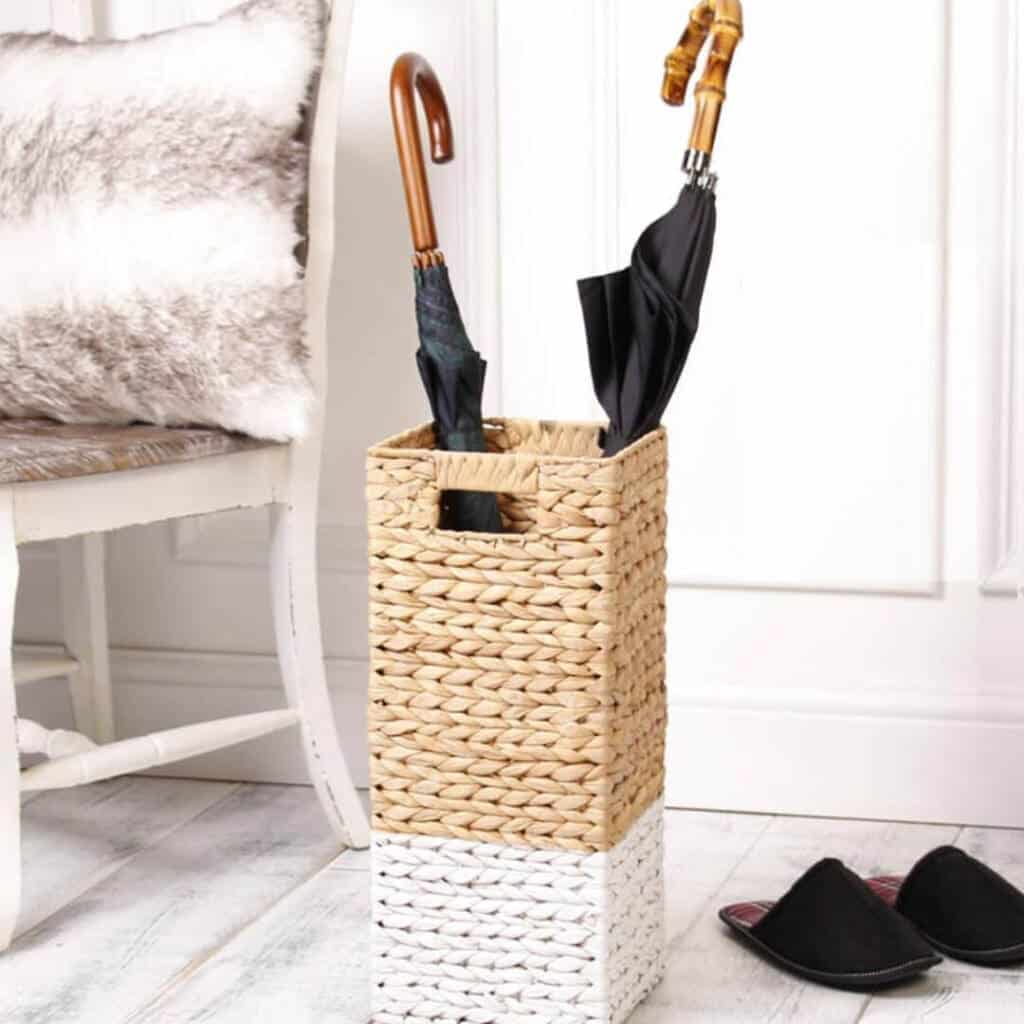One of our favorite eco-friendly materials is water hyacinth. We love the look and feel of this natural material. As environmental concerns continue growing, more people seek sustainable alternatives to their everyday products.
Water hyacinth baskets are products that have gained popularity in recent years. These natural baskets are beautiful and versatile but are also eco-friendly and sustainable. We explore water hyacinth, how it is grown, dried, and woven, and why it is considered eco-friendly. Read on as we also explore eleven ways water hyacinth baskets can be sustainable storage solutions.
Table of Contents
- What Is Water Hyacinth?
- How Is Water Hyacinth Grown, Dried, And Woven?
- Why Is Water Hyacinth Considered Sustainable?
- Water Hyacinth From Invasive Plant To An Eco-friendly Resource
- 11 Ways In Which Water Hyacinth Baskets Can Be Used For Sustainable Storage
- Frequently Asked Questions About Water Hyacinth
- Related Content
What Is Water Hyacinth?
Water hyacinth is a free-floating aquatic plant native to South America but can now be found in many parts of the world, including Vietnam and other parts of Asia. The plant is known for its rapid growth and can double in size in just two weeks.
The leaves of the water hyacinth are green and glossy, and the plant produces beautiful lavender flowers about 8cm in diameter.
How Is Water Hyacinth Grown, Dried, And Woven?
Water hyacinth is typically grown in shallow freshwater bodies such as ponds, lakes, and slow-moving rivers. The plant requires a warm and humid climate and can thrive in areas with temperatures ranging from 12°C to 30°C.
The process of weaving water hyacinth baskets starts with harvesting the plant. Once harvested, the plants are dried in the sun for several days until they become hardened.
The dried plant is sorted by color and quality before being handwoven into baskets by skilled artisans. The baskets are woven using various techniques and can be designed in different sizes and shapes.
Why Is Water Hyacinth Considered Sustainable?
Water hyacinth is considered sustainable for several reasons. Here are some of the main reasons:

Water Hyacinth Is Considered Fast Growing
Water Hyacinth plant is fast-growing and readily available, making it a renewable resource. Because the plant grows so fast, it is an excellent material for baskets, home decor, and furniture products.
Water Hyacinth Production Is Labor Intensive And Has A Low Carbon Footprint
Weaving water hyacinth baskets is labor-intensive and requires minimal machinery, giving it a low-carbon footprint industry. This makes it an ideal material to use.
Water Hyacinth is Biodegradable
Water hyacinth baskets are biodegradable, decomposing naturally, and not contributing to environmental waste.
Water Hyacinth From Invasive Plant To An Eco-friendly Resource
As a non-native invasive species, water hyacinth has caused significant ecological and economic damage in many parts of Asia. The plant can grow incredibly fast, doubling its population and size in just a few weeks, and has a high reproductive capacity, allowing it to spread rapidly.
This growth can clog waterways, obstruct navigation, and cause water quality problems, leading to a decline in biodiversity and the loss of aquatic habitats. In many parts of Asia, water hyacinth has been considered a nuisance plant and a significant threat to water resources.
However, in recent years, water hyacinth has also been recognized as a valuable resource for producing various products, including water hyacinth baskets. Harvesting water hyacinths for these products provides a sustainable way to manage the invasive plant, preventing it from causing ecological harm and providing an economic opportunity for local communities.
Water hyacinth baskets are now being produced in many parts of Asia, including the Philippines and Vietnam. The weaving of these baskets provides a source of income for rural communities, particularly women, who often have limited opportunities for work.
The baskets are also being exported to other parts of the world, including Europe and North America. They are becoming increasingly popular due to their eco-friendliness and unique style.
This is one reason why using water hyacinths for basket weaving and other products provides a sustainable way to manage invasive plants, prevent ecological harm, and provide economic opportunities for local communities. By transforming water hyacinth from a nuisance plant to a valuable resource, we can promote environmental sustainability and support the livelihoods of people in rural communities
11 Ways In Which Water Hyacinth Baskets Can Be Used For Sustainable Storage

We love the water hyacinth material, and here are eleven of our favorite ways that water hyacinth can be used for all kinds of storage solutions:
- Fruit and vegetable storage: Water hyacinth baskets are perfect for storing fruits and vegetables due to their breathable nature.
- Umbrella Stands – Water hyacinth can be used to store and keep umbrellas near your doorway.
- Magazine and book storage: Water hyacinth baskets can be used to store magazines and books, keeping them organized and easily accessible.
- Bathroom storage: These baskets can store towels, washcloths, and other bathroom accessories.
- Closet storage: Use water hyacinth baskets to store clothing and shoes, keeping them organized and easy to access.
- Toy storage: Water hyacinth baskets are perfect for storing children’s toys, helping to keep the room clean and clutter-free.
- Office storage: Use these baskets to store files, papers, and other office supplies.
- Pet toy storage: These baskets can be used to store pet toys, making it easy for your furry friends to find their toys when they want to play.
- Laundry storage: Water hyacinth baskets, such as dirty clothes or clean towels, can store laundry.
- Pantry storage: Use these baskets to store pantry items such as canned goods, snacks, and cereals.
- Plant storage: Water hyacinth baskets can store potted plants, adding a natural and eco-friendly touch to your home decor.
Water hyacinth baskets are an eco-friendly, sustainable storage solution with many benefits. Not only are they beautiful and versatile, but they also provide a renewable resource that helps control invasive plant species growth.
Weaving water hyacinth baskets is labor-intensive and requires minimal machinery, making it a low-carbon footprint industry. Water hyacinth baskets are biodegradable, decomposing naturally, and not contributing to environmental waste.
With a wide range of uses, from fruit and vegetable storage to plant storage, water hyacinth baskets offer a sustainable way to keep your home organized and clutter-free. Choosing water hyacinth baskets as a storage solution can positively impact the environment and support sustainable livelihoods for rural communities.
If you are interested in seeing how Mondoro can help you manufacture water hyacinth baskets or other products – we would love to talk to you to see how we can help you.
Find out more about how Mondoro can help you create, develop, and manufacture excellent home decor and furniture products – don’t hesitate to contact me, Anita. Check out my email by clicking here or become a part of our community and join our newsletter by clicking here.
Mondoro gives out a FREE Lookbook to anyone interested. You can receive a copy of our latest Lookbook by clicking here.
Listen to our Podcast called Mondoro Company Limited. You can find it on all major podcast platforms. Try out listening to one of our podcasts by clicking here. Subscribe to our Mondoro Company Limited YouTube Channel with great videos and information by clicking here.
Frequently Asked Questions About Water Hyacinth
How did water hyacinth spread to different parts of the world?
Water hyacinth was likely spread by humans, either intentionally or unintentionally, through plant transport for ornamental purposes or as a food source.
Why is water hyacinth considered a problem?
Water hyacinth is a problem because it can rapidly reproduce and form dense mats on the surface of water bodies, which can block sunlight from reaching underwater plants and animals, deplete oxygen levels, and impact water quality.
What are the benefits of using water hyacinth as a material?
Water hyacinth is a great material because it is sustainable, renewable, biodegradable, and can be used to make various products such as baskets, furniture, and handicrafts.
Is water hyacinth toxic?
Water hyacinth is not toxic, but it can absorb pollutants from the water it grows in
Can water hyacinth be used for composting?
Yes, water hyacinth can be used for composting as it is rich in nitrogen and other nutrients.
Can water hyacinth be controlled?
Yes, water hyacinth can be controlled through various methods such as manual removal, chemical treatment, biological control, and mechanical harvesting.
How can water hyacinth be used for environmental purposes?
Water hyacinth can be used for environmental purposes by being used in phytoremediation, which is the use of plants to remove pollutants from the water.
How was water hyacinth introduced to Asia?
Water hyacinth was likely introduced to Asia in the late 19th century through the transport of the plant for ornamental purposes, and it quickly spread throughout many parts of the continent.
How is water hyacinth harvested for use as a material?
Water hyacinth is typically harvested manually by cutting the plants and then drying them in the sun. The dried plants can then be processed into fibers that can be used to make a variety of products.
What are some environmental impacts of water hyacinth?
Water hyacinth can have negative environmental impacts such as blocking sunlight from reaching underwater plants and animals, depleting oxygen levels in the water, and altering aquatic ecosystems.
How can the use of water hyacinth be integrated into sustainable development strategies?
The use of water hyacinth can be integrated into sustainable development strategies by promoting the development of local value chains, supporting small-scale production and entrepreneurship, and incorporating sustainable harvesting and processing practices.
Related Content
About Weaving Water Hyacinth Baskets Into Home Décor Products
Water hyacinths used to be a nuisance on the waterways around Vietnam as the water hyacinth plant grows on the water and is fast-growing. Today the plant is cut and dried and then handwoven into beautiful baskets and other home decor products. The water hyacinth material can be left in its natural color, dyed, or painted in various shapes and forms.
You can discover more by reading About Weaving Water Hyacinth Baskets Into Home Décor Products by clicking here.
5 Types of Seagrass Weaving Styles You Need to Know
A seagrass rug is a great natural addition to your home.
Five basic seagrass weaving materials or styles are used to weave all seagrass baskets and other Home Decor products. All of these use seagrass material, but their material can give the seagrass product a unique look and feel.
To learn more about the 5 Types of Seagrass Weaving Styles, You Need to Know, click this link.
Water Hyacinth Vs. Seagrass Materials
Water hyacinth and Seagrass materials are two materials used by handweavers in Vietnam to hand-weave home decor products, including baskets. Seagrass is a material that grows completely underwater in salty, shallow waters. Water hyacinth also needs moisture to grow, but the water hyacinth plant will grow in tropical and sub-tropical regions on top of the water.
You can discover more by reading Water Hyacinth Vs. Seagrass Materials by clicking here.

